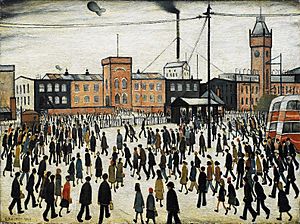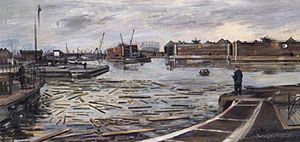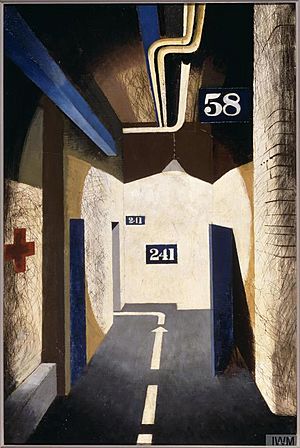War Artists' Advisory Committee facts for kids
The War Artists' Advisory Committee (WAAC) was a special group set up by the British government. It started in 1939, right when World War II began. Its main goal was to create a huge collection of art showing what Britain was like during the war.
The WAAC did this by hiring artists, some full-time and some for short projects. They also bought art from other artists. When the committee finished its work in 1945, it had collected 5,570 pieces of art from over 400 artists! More than half of this amazing collection, about 3,000 artworks, went to the Imperial War Museum. Other pieces were sent to museums and places all over Britain and the world.
Contents
Why the WAAC Was Created

The main idea behind the WAAC was to create a visual record of the war. They wanted to show what was happening at home and abroad.
Sir Kenneth Clark, who was in charge of the National Gallery art museum, was key to starting the WAAC. When World War II began, many artists lost their jobs. Art galleries closed, and people stopped buying art. Clark worried that artists would have no work. He wanted to make sure artists could keep painting and drawing. This way, they could create a lasting record of the war for the future.
Clark also hoped that by giving artists jobs, they wouldn't have to join the army and risk their lives. The WAAC also used art to help with propaganda. They wanted to keep people's spirits up by holding art shows. Showing British war art in America in 1941 also aimed to convince the United States to help Britain during the war.
Who Was on the Committee
The WAAC members met once a month at the National Gallery in London. The group included people from government departments, the armed forces, and art schools.
Some of the important members were:
- Sir Kenneth Clark: He was the leader of the WAAC.
- Muirhead Bone: A famous artist and a trustee of the Imperial War Museum.
- Percy Hague Jowett: An artist and the head of the Royal College of Art.
- Walter Westley Russell: An artist and the Keeper of the Royal Academy Schools.
- Representatives from the War Office, Navy, and Air Ministry.
Even as the war went on, Clark, Bone, and Russell stayed active members of the committee.
How the WAAC Worked
The WAAC worked in a few ways:
- They hired artists on full-time contracts.
- They gave short-term jobs to artists for specific projects.
- They bought finished artworks that artists offered to them.
In total, the WAAC collected art from about 400 different artists. They also gave artists special permits. These permits allowed artists to go into restricted areas and get materials that were hard to find during wartime. For example, good paper and sculpture materials were scarce.
Most of the early WAAC art focused on the British home front. This showed what life was like in Britain during the war. But as the war continued, 26 artists were sent overseas. They went to places like the Middle East, Malta, France, and South-East Asia.
Sadly, three artists working for the WAAC were killed during the war: Thomas Hennell, Eric Ravilious, and Albert Richards.
Art Shows and Exhibitions
The WAAC organized many art exhibitions. They showed the war art both overseas and across the United Kingdom.
Shows Abroad
- Britain at War: This was a big show that opened in New York in May 1941. It featured paintings and drawings from over 30 artists. The goal was to encourage America to join the war. The exhibition then traveled to other cities in America and Canada.
- India in Action: This show toured Australia, New Zealand, and the United States in 1944 and 1945. It had 51 drawings by Anthony Gross, showing Indian soldiers in the Far East.
- Over 100 pictures were shown in South Africa from 1944 to 1947.
Shows in the UK
The WAAC held many exhibitions all over Britain.
- The Museums Association helped organize a show that visited 65 different places, mostly museums.
- Four other exhibitions toured to 80 smaller, more local places.
- The National Gallery in London used its space to show WAAC art. This was because the gallery's own collection had been moved to safety. New artworks were added regularly, and the exhibition stayed open throughout the war.
- The War at Sea: This show at the National Gallery in 1944 featured 52 paintings by Norman Wilkinson. He was a Navy veteran and painted what he saw on Royal Navy ships.
- In 1945, 400 artworks from the collection were shown at the Glasgow Art Gallery.
- The final WAAC exhibition was held in London in late 1945. It displayed over 1,000 drawings, paintings, and sculptures.
What Happened Next

The WAAC officially closed down in December 1945. Its work was then taken over by the Imperial War Museum.
The biggest job after the war was deciding where to send the huge art collection. The WAAC had collected 5,570 artworks! By the end of 1947, these works had been sent to about 60 museums, galleries, and government offices in Britain and around the world.
The committee made sure that art by the most famous artists was shared widely. For example, Henry Moore's 27 drawings of coal mines and London Underground shelters went to 11 different museums. Over half of the entire collection, about 3,000 pieces, went to the Imperial War Museum. The Tate museum received 76 artworks, and the British Council got about 25 pieces.
WAAC Artists
The WAAC hired many artists to create their wartime collection. Thirty-six men and one woman were given full-time jobs. Another 100 artists received short-term contracts. The committee also bought works from 264 other artists, both professional and amateur. Three artists even donated their work to the collection. Some well-known artists who worked with the WAAC include Henry Moore, Graham Sutherland, L.S. Lowry, and Laura Knight.
See also
- War artist
- British War Memorials Committee




